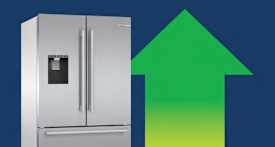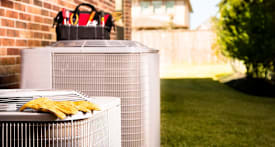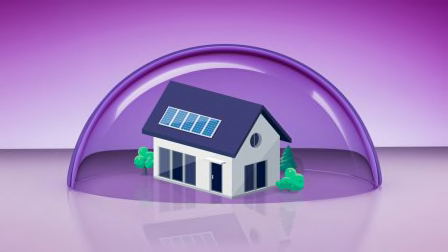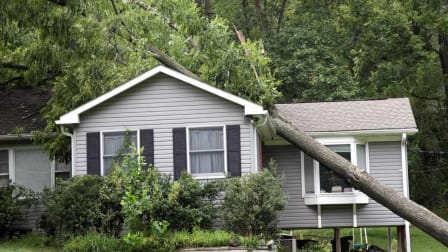Why Home Insurance Costs So Much—and How to Pay Less
Blame natural disasters, inflation, or your location. These tips will help you whittle down rising premiums.
You don’t have to live in a disaster-prone place for your homeowners insurance bill to make you feel like disaster has struck. Homeowners insurance premiums have risen significantly throughout the U.S. in the past year and are expected to continue to soar. On average, homeowners saw a 12 percent jump in premiums in 2023, and then an additional 6.9 percent increase in the first half of 2024, according to the business analytics firm S&P Global Market Intelligence. Historically, homeowners insurance bills have risen only about 5 percent a year.
What’s behind these scary numbers? Read on for answers—and for solutions to help you save money. And if you’re shopping for coverage, check Consumer Reports’ homeowners insurance buying guide. CR members can consult our exclusive survey-based homeowners insurance ratings for the best companies across the U.S.
Blame the Weather
Insurance experts generally agree that two major forces have pushed insurance premiums skyward: more frequent severe weather events, and the increased building and construction costs incurred when fixing storm-caused damage, says Chuck Bell, senior policy analyst for CR.
Building Inflation Hits Hard
Higher construction costs also have a big impact on what homeowners will see in their policy renewal letters this year. When material and labor expenses go up, so do premiums. Between June 2019 and June 2024, labor for construction trade services rose 40 percent, while the cost of construction materials increased by about the same amount. Though prices have dropped for some building materials, like lumber, inflation hasn’t completely abated for other needed products.
Find out what to do if your homeowners insurance has been canceled or the premium has skyrocketed.
What You Can Do to Save on Homeowners Insurance
If you want to hunt down the best value for your insurance dollar, comparison shopping is a good way to start. Companies’ judgments of you and your property won’t be identical, so you may get a more favorable price from one company than from another. Just make sure you’re comparing coverage apples to apples.
Switching insurers is fairly common. Twenty-one percent of Consumer Reports members surveyed recently about the experiences they’d had with their homeowners insurance companies said they’d switched carriers in the previous five years. Of those, 62 percent said they did so to get better rates—or because their old insurer had raised its rates. (Results are based on 59,670 responses, reflecting 65,000 experiences with homeowners insurers.)
Keep in mind that it’s key to establish the right replacement cost for your home so you’ll be covered if it gets destroyed. For that reason, consider using a local, independent agent or broker who sells policies from several insurance companies vs. an online vendor, says CR’s Bell. These professionals can go over how the different companies have determined the replacement cost of your home, and they may also recommend policy add-ons that can help your coverage keep up with inflation. (Find an agent through Trusted Choice, which is affiliated with numerous such companies.)
However, you may still want to do an initial search for coverage online to get a sense of what might be available. Consider The Zebra and Policygenius, both of which provide quotes from a variety of insurers. (Bear in mind, however, that these sites might not include all companies, and they are likely to share your contact information with specific insurers who will then contact you directly.) Once you get a quote through one of these aggregators, you take it to your local independent broker, says CR’s Bell, or act on it directly. Keep in mind, though, that the local broker can help set up the coverage and possibly even get you a better rate or find additional discounts. Also check with your state insurance department, which may publish rate comparisons. Floridians, for instance, can go to Florida’s Office of Insurance Regulation; Californians, to the California Department of Insurance.
CR members can consult Consumer Reports homeowners insurance ratings to identify companies that best satisfied the 59,670 members who responded to our survey. We judge carriers on price, breadth of coverage, nonclaims customer service, and other factors. We also rate them on claims handling, including how satisfied members are with the dollar amount they receive.
Has Extreme Weather Increased the Cost of Your Home Insurance?
Use These Other Money-Saving Tactics
The first quote you get from an insurer might not be what you ultimately pay, says Collins of the APCIA. There are steps you can take to lower your premiums. These strategies can help.
Bundle coverage. Purchasing your homeowners and auto coverage from the same company can provide savings of up to about 30 percent overall. You could save more, too, if you bundle your boat or motorcycle. Bundling insurance policies also can simplify your bill paying and record-keeping, according to the Insurance Information Institute.
Keep your deductible high. Higher deductibles equal lower premiums. Going to a $1,000 deductible from $500, for instance, can shave your premium by 25 percent, the institute says. And going from $500 to $2,500 potentially saves even more.
Clean up your credit. Insurers in 46 states can use what’s called a credit-based insurance score in their pricing of homeowners insurance premiums. They can also check your score regularly and use it in their renewal pricing. An analysis by Policygenius found that poor credit can generate a premium twice as high as good credit. To improve your odds, don’t take on too much credit card debt in the months before insurance shopping, and pay your bills on time.
Check your credit reports for free at annualcreditreport.com regularly to identify errors and have them corrected. And ask the insurer what impact your credit score is having on your premium. “If your rates are higher because of your credit history, the insurer should tell you the source of the report—LexisNexis or Experian, for instance—so you can review it,” says CR’s Bell. (CR has argued against the use of credit in insurance pricing, and using credit scores for homeowners insurance pricing isn’t allowed in California, Maryland, Massachusetts, or Michigan.)
When You’re Ready for Home Improvements, Consider These
Mitigating the risks to your home can also moderate the cost of insurance. You might not want to undertake a major project just to save a few hundred dollars on homeowners coverage, but in some cases, repairs such as fixing or upgrading your roof might net an appreciable cost savings—or even be required to obtain coverage. When you’re ready to tackle a job, here’s where to start.
Landscape with fire in mind. Cutting back dry brush around dwellings and outbuildings in a fire-prone area can earn you a 5 percent break on your premium. It might even be required by an insurer in some cases. CR has heard from dozens of readers who say insurers insisted they cut back branches or remove trees near their home in order to retain coverage.
Add or replace home systems. Replacing old plumbing and adding a home security system and gas- or water-leak detectors can lead to insurance savings of 2 to 6 percent or more. The online insurer Hippo offers 13 percent off your policy for a security system with professional monitoring.
Upgrade the roof. This part of your house is often where problems start, from water leaks to fires from wind-borne embers. So some insurers add a surcharge of 10 to 15 percent for older roofs. (A Policygenius analysis found major insurers charging from 22 to 40 percent more for a 20-year-old roof vs. a new one.) Check CR’s ratings of asphalt roofing shingles if you’re ready to replace your roof. And in a hurricane- or tornado-prone area, go to Fortified to learn how to install an impact-resistant roof system that could make you eligible for a 35 percent discount from some insurers.
In Florida, you may have no choice but to upgrade your roof, by the way. Some insurers won’t cover roof damage unless the roof is newer than 10 years old, says Melanie Musson, an insurance expert at Clearsurance, an insurance shopping website.








